 |
 Return to Methods List |
Methods in Neuroscience Scallop Retina - RECORDING 1 |
| The scallop retina contains two different types of photoreceptors Important note about the videos - the videos on this page were taken in the dark. You may need to turn out the lights in your room to see them. |
|
 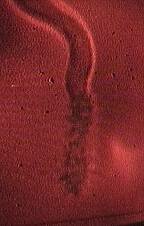 The scallop retina is interesting because it contains two different types of photoreceptors. One type of photoreceptor, shown above, is like most other invertebrate photoreceptors in that it depolarizes in response to light (arising from a phospholipase C signalling pathway). It is a rhabdomeric (microvillous) cell. The photo on the right is an enlargement of the microvillous portion of the cell where the signal transduction apparatus are located. The scallop retina contains no second order neurons (like amacrine cells or ganglion cells). This is one very nice feature of this preparation - you can dissociate the retina and obtain only photoreceptor cells! Click HERE for a 30-second (4.5MB) video showing this type of cell under the microscope. |
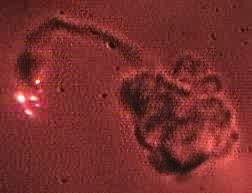 The second type of photoreceptor, shown here, hyperpolarizes in response to light, using a cGMP pathway for signalling. (See Gomez and Nasi, 1995 for more information about signal transduction (Neuron. 1995 Sep;15(3):607-18)). Most vertebrate photoreceptors hyperpolarize in response to light. In the scallop, it is likely that these hyperpolarizing photoreceptors allow the animal to detect predators: normally the cells sit in light and are thus hyperpolarized. When the shadow of a predator crosses the eye, these photoreceptors depolarize and cause a response which could allow the animal to escape. On the cell body you can see the modified ciliary appendages that form small spherical structures that protrude from the cell. Click HERE for a 30-second (4.6 MB) video explaining the different cell types. Click HERE to continue the explanation (1.9MB). Because the scallop retina contains both hyperpolarizing and depolarizing photoreceptors, it can be used to study the mechanisms of phototransduction for these two different responses. |
 A second photo of a rhabdomeric cell taken by Gomez and Nasi. A=axon; S=soma; R=rhabdomere. Calibration bar = 10 microns. |
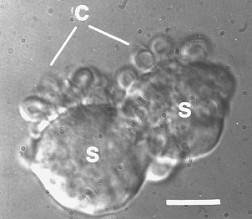 A second photo of two ciliated cells taken by Gomez and Nasi. C=cilia; S=soma. Calibration bar = 10 microns. |
| Recordings from scallop photoreceptors can be made using typical patch clamp techniques. | |
 Here the tip of the micropipette is being firepolished. |
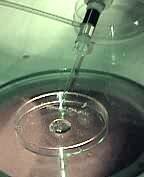 Then the tip is suction-filled with the pipette solution by holding the tip of the pipette in a small amount of pipette solution and applying suction to the back of the pipette holder. Only a small amount of pipette solution will be sucked up into the pipette, but doing this removes air from the pipette tip. |
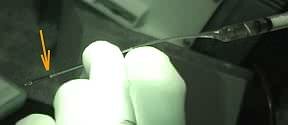 and the rest of the pipette is backfilled. It's easy to see the level of the recording solution (orange arrow) in the pipette. |
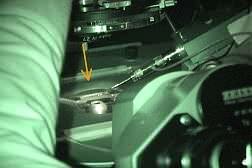 After the pipette is screwed into the headstage and moved into position over the recording objective, the microscope condenser is lowered into place. |
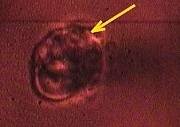 Here the microscope is focused on the cell body of one of the cells that hyperpolarizes in response to light (via activation of a primarily K+ -selective conductance). |
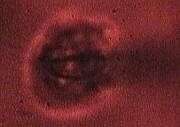 Here you can see the patch pipette as it touches the cell body. |
 Here the website designer has colored the patch pipette orange so it can be seen better. |
| Overview | Web Lectures | Fellowships | Activities | Home | SFN | NAS | IBRO |